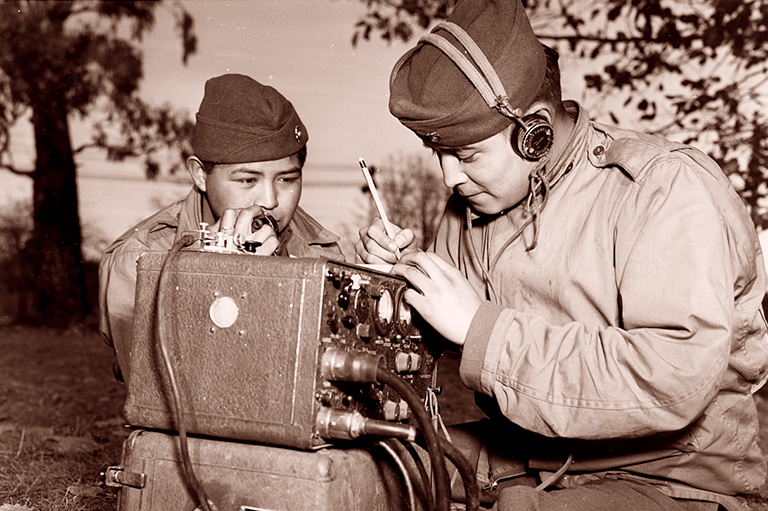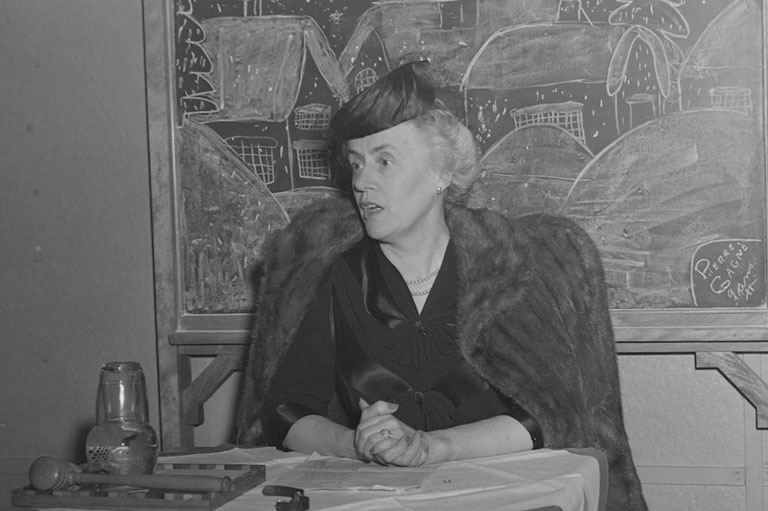Kate Siklosi’s “hand to object care” and the Charter of Rights and Freedoms
Grade Levels: 5/6, 7/8
Subject Area: Social Studies/History/Politics/Art
This lesson is inspired by the Rights and Freedoms issue of Kayak: Canada’s History Magazine for Kids.
Lesson Overview
Students will apply aesthetic and historical thinking skills using the work of Canadian artist Kate Siklosi and the Canadian Charter of Rights and Freedoms to develop an understanding of historical injustices.
Time Required
4-5 hours
Historical Thinking Concept(s)
- Identify continuity and change
- Analyze cause and consequence
- Take historical perspectives
- Understand the ethical dimension of historical interpretations
Learning Outcomes
Student will:
- Gain an appreciation that prior to the Charter of Rights and Freedoms (1982) there were significant injustices in Canadian law.
- Create an aesthetic response in the style of artist Kate Siklosi in order to speak to these injustices and how they would have been challenged by the Canadian Charter of Rights and Freedoms.
Background Information
While Canada has been a great place to live for some people, others have had to struggle with oppression, including things like racism and homophobia. Before the Canadian Charter of Rights and Freedoms was signed into existence in 1982, there were limited protections for people who were not of the dominant majority.
Contemporary artist Kate Siklosi produces works relating to the Canadian Charter of Rights and Freedoms. Her works comment on “the complexities of our world” (Siklosi, 2020).
This lesson will help students understand some of these instances through the approaches of Siklosi’s art.
Lesson Activity
Inquiry Questions:
How would the Canadian Charter of Rights and Freedoms have impacted Canadian history, had it been in place earlier? How can art be used to communicate the complexities of the Canadian Charter of Rights and Freedoms and Canadian law?
Activating:
-
Have students examine the work of Torontonian artist Kate Siklosi, entitled “conjure” (2020). Using the Capacities for Higher Learning from the Lincoln Center, students will notice deeply, ask questions, make connections, and create meaning. See the section Teacher Materials for excerpts on Siklosi’s work and a short description of the nine Capacities for Higher Learning.
-
The teacher should lead the discussion, asking what the students notice about the artwork, what questions they may have, what connections they can make, and what meaning they can apply. Note: there is no right or wrong answer here. This will open up a conversation regarding the Charter of Rights and Freedoms (1982).
-
Also consider that Siklosi’s art focuses on “hand to object care and contact” (Siklosi, 2020); what does this mean? How does she use this to further understanding about the Canadian Charter of Rights and Freedoms? Potential responses could be that Siklosi produces her work intentionally and thoughtfully because the issues that she explores are complex and multi-faceted. She chooses to highlight specific words and objects that may change with the addition of new meaning, like what can happen with the context of Canadian law and the Canadian Charter of Rights and Freedoms.
-
- Have students explore one or more of the following topics relating to historical injustices in Canada.
- Gross Indecency: The Everett Klippert Story (The Calgary Gay History Project)
- The Story of Africville (The Canadian Museum for Human Rights)
- History Bits: “Remembering Africville” (Canada’s History)
- The Indian Act: A Summary (Historica Canada, 2022)
- Japanese Canadian Internment (Legion Magazine, 2016)
Note: There are many other injustices that could be explored; these are just a small sample. Other potential topics include First World War internment camps, suffrage, residential schools, Chinese Head Tax, Komagata Maru incident, or many of the other atrocities that would have been gross misconducts of Equality Rights.
Acquiring:
Have students share in small groups (3-4 students per group) how Kate Siklosi’s “conjure” (2020) and any of the historical sources are connected. Have them report back to the large group their observations and reflections.
Applying:
Task students with creating their own object of “hand to object care” (Siklosi, 2020).
- Have the students choose one or two lines of the Charter they can cut out to use as a part of their piece.
- Students can then use drawing, collage, or found objects to produce their art work. Have them keep in mind the medium needs to match the message. How can the media help further understanding about the topic at hand?
- This could be done as a permanent piece, by having the students mount their drawings, using Charter quotes and found objects on more permanent fixtures, like heavy card stock, or even small canvases. Or, this could be done more in a manner of Siklosi’s art, where the art is only temporary, and exists through documentation.
- Then, have the students generate an artist statement. This should either explain the materials used and the meaning behind them or the historical impact of the chosen event(s) on the people targeted in relation to the Canadian Charter of Rights and Freedoms. The artist statement can be tailored as needed to specific classes or lessons, but a good recommendation is three examples and three explanations, for about a paragraph.
Teacher Materials
Quote from Kate Siklosi (2020) on her work:
“I’m currently experimenting with a project I’m calling conjure, which features work created in petri dishes with water, ink, fragments from the Canadian Charter of Rights and Freedoms, and various found objects. After each instance, I dump the contents of the petri dish into my sink and try something new. This series shows a finished piece from that project, as well as snaps of my work in progress. This work of experimenting with my hands, of indulging in hand to object care and contact, is the way by which I process and work through the complexities of our world and my being in it. Here is the work of that work, the muck of these conjurations, the failures, the tries again, everything and the kitchen sink.”
Capacities for Higher Learning (excerpted from Aesthetic Education, Inquiry, and the Imagination, 2007, 2009, The Lincoln Center for the Performing Arts, Inc. Developed by Lincoln Center Institute.) :
-
Noticing Deeply: To identify and articulate layers of detail in a work of art through continuous interaction with it over time.
-
Embodying: To experience a work of art through your senses, as well as emotionally, and also to physically represent that experience.
-
Questioning: To ask questions throughout your explorations that further your own learning; to ask the question, “What if?”
-
Making Connections: To connect what you notice and the patterns you see to your prior knowledge and experiences, as well as to others’ knowledge and experiences...
-
Identifying Patterns: To find relationships among the details you notice, group them, and recognize patterns.
-
Exhibiting Empathy: To respect the diverse perspectives of others in our community, to understand the experiences of others emotionally as well as in thought.
-
Creating Meaning: To create your own interpretations based on the previous capacities, see these in the light of others in the community, create a synthesis, and express it in your own voice.
-
Taking Action: To act on the synthesis of what you have learned in your explorations through a specific project. This includes projects in the arts, as well as in other realms...
-
Reflecting/Assessing: To look back on your learning, continually assess what you have learned, assess/identify what challenges remain, and assess/identify what further learning needs to happen. This occurs not only at the end of a learning experience, but is part of what happens throughout that experience. It is also not the end of your learning; it is part of beginning to learn something else.
Materials/Resources
-
Access to Kate Sikloski’s website
-
Videos or articles on past human rights injustices
-
Various art supplies — suggestions include charcoal, small found objects, watercolour, acrylic paint, small canvases, cardstock or watercolour paper, paintbrushes, pencil crayons, pencils, containers for water/paint
-
Either printed sections of the Charter to cut out or to reference, if students want to write out their sections
Assessment
Have students reflect on their work for their assessment. This one point rubric could be formative or summative. Students fill out one row per outcome to explain if they haven’t achieved the target, have met the target, or surpassed the target.
Themes associated with this article
Advertisement




